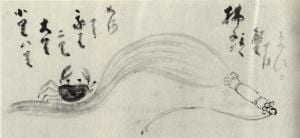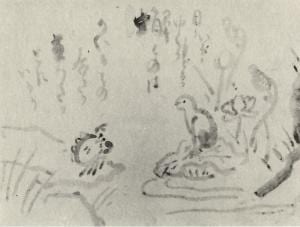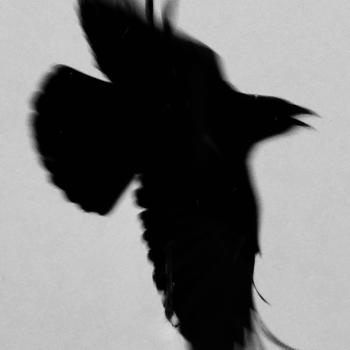
“Zen could be said to be the biggest joke that has ever been played in the spiritual realm. But it is a practical joke, very practical. However, there is a difference between a joke and a trick. One of the problems that we in America have ended up with is that when people try to be ‘Zennie,’ they do that by being tricky.” – Chogyam Trungpa Rinpoche (1)
The robes, the posture, the decorum – all of these can contribute to the trick, that Zen is a spiritual masquerade. So in this post, I want to continue chipping away at that notion, the notion that Zen is about any particular way of being. Because as Trungpa goes on to say, “…trickiness undermines others’ openness, and the whole thing feels so extremely awesome and reverent, so solid and solemn.”
Enter Hakuin and his painting above and below. Rather cute (or crude) cartoons. The drawing above presents us with a riddle: “I have eight small legs and two large legs. Who am I?”
The whisk says, “Aren’t you a crab?”
An animated presentation of the dream land (makyō), with talking crabs and whisks too. And a truth inquiry that’s hidden in the open. “Who am I?”
The lowly crab was one of Hakuin’s frequently visited themes, emphasizing the radical immanence of the buddhadharma in a not-so-flipping-serious Zen way. In that vein, Tanahashi notes Hakuin-esquely, Zen numerology (tongue-in-cheek) way (as those of you who studied Hakuin in the Vine last year would surely attest), that the eight legs represent the eightfold path and the two pincers represent the “perfection of happiness” and the “perfection of wisdom.”
Here’s Another

The caption says,
“Mr. Crab, are you going forward or backward? Are those eyes or pimples?”
“Mr. Frog, are you sitting or standing? Or somewhere in between?”
Again, “who are you?” is the lighthearted, dead-serious theme. It’s a joke, not a trick.
The frog teases the crab for being a crab and the crab teases the frog for being a frog. Sound familiar?
Crab Sensei
And finally, here’s a longer piece for which there doesn’t appear to be a surviving graphic presentation.
286. BOTH ARMS RAISED up high, both eyes staring like stalks at the blue sky, this tiny riverside creature scrabbles its way into the reeds. On looking more closely, I discovered that it was Crab Sensei.
Addressing him, I said: “Ah! How strong and brave you are, even as you humble yourself before all things for your peace and security. The trouble comes when someone gets puffed up and arrogant. You always gaze upward as though worshipping the Buddha’s blue eyes, like you were one of the host of eighty thousand who attended the preaching at Vulture Peak. It is a gaze that takes everything in, like that of the usurper Wang Mang, (2) whose loathing enemies would even today devour him alive. It is the gaze of a cat who pretends to doze under a peony in the warm spring sun, and suddenly leaps to catch a butterfly. It is the gaze of a Zen monk steadily scanning the distant heavens and aspiring to the freedom to transcend those heights (though this is a perilous trap for him). But what is your real intent in assuming that brave and manly attitude with your six legs and two pincers and revering Heaven like that?”
Crab Sensei replied, “I have my reasons for scuttling sideways the way I do. I’m not just indulging in some cheeky sport. I must also point out that I am different from the four examples you just gave.”
With deepest respect I then said to him, “I was sure that was the case. Would you please fill me in on the particulars of that difference?”
Shuffling and scuttling around, Crab Sensei whispered in a tiny voice, “To tell the truth, I’m quite an ignorant fellow. I’m not sure myself. I’ve just always acted like this.”
“Could that be your original nature?” I asked.
Edging sideways, Crab Sensei said, “I don’t know. I don’t know” and disappeared into the reeds. (5)
Comment
Crab Sensei, with six legs and proclivity to hide away, is probably not technically a crab, but an Anomurans, aka, Hermit Crab. Hakuin looks closely to discover this hermit and then bathes them in (feint?) praise, especially in his description of the hermit’s gaze – worshipful, hungry, and set on gain, using practice as a trick to get out of the present circumstance, what Hakuin calls a “perilous trap.” Oh, Crab Sensei, what is your real intention?
Crab Sensei continues with the hermit strategy, unwilling to acknowledge being seen by the teacher. I’ve employed this a time or two, and seen some students in dokusan wiggling this way and that as well, pincers at the ready, and not necessarily ready to clamp onto the “perfection of happiness.”
Look at the skillfully delicate approach Hakuin uses, “With deepest respect … please fill me in….”
Crab Sensei, of course, is just being an unselfconscious crab. For a crab, scuttling around, glaring at the heavens, wildly fraying about with pincers, is something close to its original nature. For a human being who is crabby, though, even if that is your original nature, watch out with those damn pincers!
Crab Sensei says, “I don’t know,” and scuttles into the reeds. Could that be your original nature?
I’m going now to go have tea with my wife. How about you?
(1) From Lion’s Roar, Chogyam Trungpa Rinpoche, “Zen Mind, Vajra Mind.”
(2) Both paintings from Penetrating Laughter: Hakuin’s Zen & Art, Kazuaki Tanahashi, pp. 40 – 41.
(3) Waddell notes, “The usurper Wang Mang (1st century B.C.) After marrying his daughter to the Han emperor P’ing Ti, Wang Mang poisoned him, and then had his daughter name her infant son as emperor and appoint himself regent. He later declared himself emperor. When his own army later turned against him, his soldiers tore his corpse into pieces.” Complete Poison Blossoms from a Thicket of Thorn, p. 474.
(4) Hakuin Zenji, Complete Poison Blossoms from a Thicket of Thorn, trs. Norman Wadell, p. 473.
Dōshō Port began practicing Zen in 1977 and now co-teaches with his wife, Tetsugan Zummach Sensei, with the Vine of Obstacles: Online Support for Zen Training, an internet-based Zen community. Dōshō received dharma transmission from Dainin Katagiri Rōshi and inka shōmei from James Myōun Ford Rōshi in the Harada-Yasutani lineage. Dōshō’s translation and commentary on The Record of Empty Hall: One Hundred Classic Koans, is now available (Shambhala). He is also the author of Keep Me In Your Heart a While: The Haunting Zen of Dainin Katagiri. Click here to support the teaching practice of Dōshō Rōshi at Patreon.












